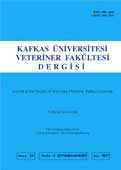
This journal is licensed under a Creative Commons Attribution-NonCommercial 4.0 International License
Kafkas Üniversitesi Veteriner Fakültesi Dergisi
2017 , Vol 23 , Issue 5
Caecal Bacterial Populations and Growth of Broiler Chickens Fed Diets with Different Particle Sizes and Forms
1Department of Animal Science, Science and Research Branch, Islamic Azad University, Tehran - IRAN2Nuclear Agriculture Research School, Nuclear Science and Technology Research Institute, Atomic Energy Organization of Iran, Karaj - IRAN DOI : 10.9775/kvfd.2017.17676 The main objective of the present study was to evaluate the effects of feed particle size, form and also pellet quality on intestinal pH, population of beneficial bacteria and pathogenic bacteria and performance of broiler chickens during growth period. Chicks were fed the same starter ration, but at day 11 of age, chickens were randomly assigned to eight treatments and four replicates and fed dietary treatments until day 28 of age as grower diet. Dietary treatments were as: pellet diets with (1.8 and 2.2 mm) or without dust, graded diets (0.78 and 1.27 mm) and mash diets (2 and 3 mm diameter), poor quality pellet and high quality pellet with die diameter of 1.8 and 2.2 mm. The lowest pH of duodenal and ileal contents was for pellet 2.2 mm and mash 3 mm, respectively (P<0.05). In mash diet, chicks fed the particle size of 3 mm had 7.3% greater the relative weight of gizzard than those fed particle size of 2 mm. Daily feed intake and daily weight gain of chicks were the highest in pellet diets and the lowest in graded diet 1.27 mm. The worse feed conversion ratio was for chicks fed mash 3 mm and graded diet 1.27 mm (P<0.05). There were no differences (P>0.05) among treatments for bacterial populations, except Escherichia coli population. The highest Escherichia coli population was found in high quality pellet 1.8 mm and poor quality pellet 1.8 mm and lowest one was found in mash 2 and 3 mm (P<0.05). It was concluded that both feed form and particle size may influence on the gizzard weight and the pH of duodenal and cecal contents and Escherichia coli population in the cecal of broiler chicks. High quality pellet 2.2 mm resulted in better feed conversion ratio, although the Escherichia coli population was the highest in the cecal content of these chickens. Keywords : Broiler chicken, Bacterial population, Feed form, Particle size, Performance










